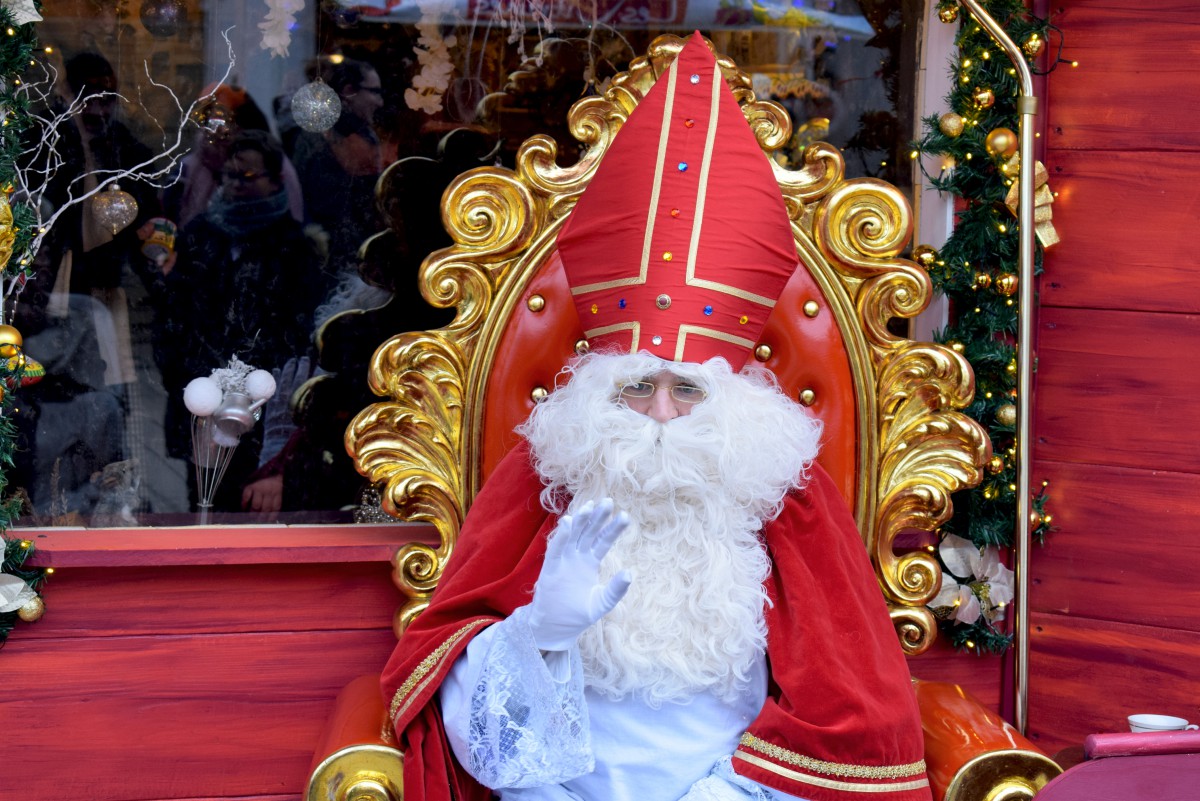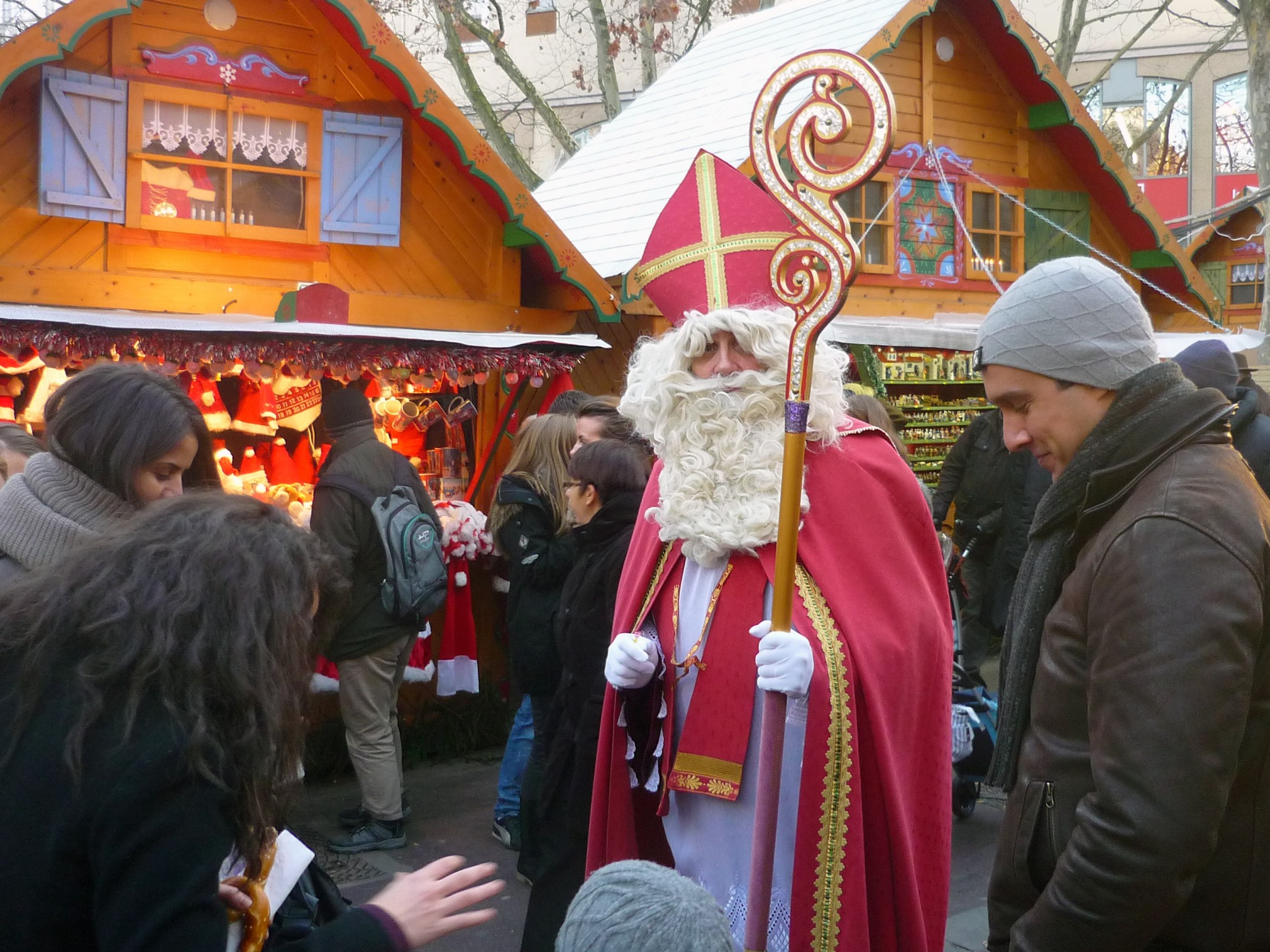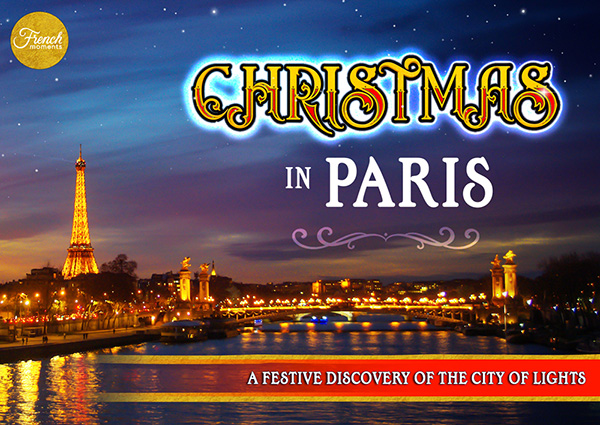Saint-Nicolas is the character who distributes presents to Austrian, Belgian, Dutch, German, French and Swiss children on the 6th December. He is often portrayed as a tall thin man with a long white beard, all dressed up in silk garments, carrying a bishop’s mitre and holding a crosier. Saint Nicolas is traditionally accompanied by a grey donkey carrying baskets filled with biscuits, sweets and gifts. When the Dutch migrated to the United States in the 19th century, they took with them the traditions of Saint-Nicolas (Sinterklaas) which gradually evolved into Santa Claus. This article will give you more insight about the legends of Saint-Nicolas.
Who was Saint Nicolas ?

Saint-Nicolas‘ life is surrounded by legends. Born into a rich family around 260 AD in Lycia, a province of southern Asia Minor, he was heir of a large fortune. A little older, he did not seem interested in playing with other children of his age and preferred going to church.
Since a young age he was known for his great generosity and from this character trait arose many legends. For instance, he apparently helped 3 girls escape from being sent into prostitution by their ruined father.
On his return from a pilgrimage to Egypt and Palestine, his uncle, the Bishop of Myra, died. While the bishops of the Assembly were praying for a successor, a voice recommended that they elect the first man to enter the Church… and Nicolas came in, convicting the priests to choose him as the new bishop!
Once elected in 303, he gained respect from his people through his constant endeavour to save them from famine and the excessive weight of taxes.
He advocated for the lost causes on many occasions.
A persecuted saint
Saint Nicolas was also subject to persecution because of his Christian faith, under the reign Emperor Diocletian (in power from 284 to 305). The Roman emperor persecuted Christians with great cruelty from 303. Saint Nicolas was arrested and imprisoned before being forced to live in exile for a while. This hardship ended around 313, when Emperor Constantine (in power from 306 to 337) eventually established religious freedom at the Council of Milan.
Saint Nicolas died around the year 345 in the harbour city of Myra in Asia Minor. The date of his death, the 6th December, became the day when the Saint is revered.
Another time he was said to have intervened against the Governor of Myra in favour of 3 innocent people whom he saved narrowly from decapitation. On another occasion he was said to have interceded in favour of 3 officers unfairly condemned by Emperor Constantine.
The connection between Saint-Nicolas and Lorraine

The Saint’s aura immediately started to be known, first in the Orient, as the protector of prisoners and the oppressed, but also of sailors. A growing number of devotees started to call upon his name in any given circumstance.
But his fame would reach Western Europe in the beginning of the 11th century, and more particularly from 1087 when sailors from Bari (a town in the South of Italy) travelled to Myra to save his corpse from Muslims and bring it back to their city.
It was around this time that Count Aubert of Varangéville brought a phalange back to the church of the little town of Port. Known today as Saint Nicolas-de-Port, the town became an important pilgrimage site of the Duchy of Lorraine. This great devotion not only attracted pilgrims, but also merchants from all over Europe.
In the 15th century, Duke René II of Lorraine consecrated Saint-Nicolas as Lorraine’s Patron, which was confirmed by Pope Innocent X in 1657.
But the attraction of the pilgrimage town decreased following the Reformation in the 16th century, as Saints celebrations were abolished in European countries that had become protestants. As for the Dutch who also revered the Saint, they kept dear the tradition of the celebration… There, Saint-Nicolas was known as Sinterklaas.
From Saint Nicolas to Santa Claus

When Dutchmen emigrated to the United States at the beginning of the 19th century, they brought with them their Sinterklaas tradition.
And the Saint quickly became Santa Claus, a moralist character whose duty was to reward good children and punish the bad ones.
In 1860, caricaturist Thomas Nast of the New York Newspaper Harper’s Illustrated Weekly dressed Santa Claus in red, doubled over in white fur with a big leather belt.
The distinctive shape of today’s Santa was created in 1931 under the initiative of the firm Coca-Cola which used the character in a commercial.
Et voilà how Saint-Nicolas mutated into an icon with a big red belly, who the French refer to as “le Père Noël”…
The legends of Saint-Nicolas
The character of Saint-Nicolas inspired many legends in Lorraine. Here are a couple of examples.
The legend of the Sire of Réchicourt
In 1230, the Sire of Réchicourt participated to the Crusades and was taken prisoner in Palestine. Thrown into a deep dungeon, he shared the company of rats. Having nothing to eat or drink, he started to pray fervently to Saint Nicolas.
He promised that if one day he was granted deliverance, he would become an even more fervent devotee when back in his native Lorraine. He fell asleep while praying and woke up the next day, on the 6th December, in front of the church of Saint-Nicolas-de-Port!
The legend of the three little gleaners
Three little children were sent by their parents to glean the field. Having worked all day, they headed up to their home, tired and hungry but got lost. After a long walk in the countryside, they ended up in front of a brightly lit house. It was the home of a butcher who was unknown to them. The children knocked on the door and the man, who seemed friendly enough, offered them hospitality. The children accepted the butcher’s offer with gratitude, thanking their providence. Starved and exhausted, nothing was better than a great meal and a good sleep. But once the children were deeply asleep, the butcher attacked them, cut their throats and slaughtered the little creatures with a knife, cutting them into small pieces before putting them in a large tub of salt. (Sorry to all the sensitive readers!)
Seven years passed by. Saint Nicolas, who heard about the atrocious destiny of the three little gleaners, came to visit the evil butcher. He knocked on the door and asked him hospitality for the night. The butcher, so flattered to welcome such a famous person under his roof, accepted with great pleasure. While Saint Nicolas was sat at the table, he asked the butcher with insistence if he could eat some little swine. The butcher’s face suddenly fell for he suddenly realised that Saint Nicolas knew everything. Fearing for the wrath of the Saint, he immediately fled out of the house into the dark night. Saint Nicolas then went down to the cellar, blessed the tub and opened it. The children came out all refreshed from the barrel, as if they were awakening from a long sleep.
This is probably the most famous legend of Saint Nicolas, and explains why the Saint has been designated as the Patron of children. Many local songs and poems in Lorraine and Alsace have been created from this story, with many different versions.
In Lorraine a medieval song for the children has been passed through generations:
A LOCAL SONG
❝Saint Nicolas mon patron, Saint Nicolas, my protector
Apporte-moi des bonbons, Bring me some sweets,
Des mirabelles Mirabelles
Pour les demoiselles, For the young girls
Des macarons Macarons
Pour les garçons. For the young boys❞
The celebrations in the Lorraine town of Saint Nicolas-de-Port

If the Saint-Nicolas’ celebrations are amazing in Nancy, other towns in Lorraine also celebrate their Patron Saint such as Metz. In the town of Saint-Nicolas-de-Port, Saint-Nicolas is obviously an important part of the local cultural life. The town organises a “secular” parade in its city-centre, followed by a grand ceremony celebrated inside the magnificent basilica. The highlight for young and old alike is when the candle procession starts which creates an aura of mystery in this imposing edifice.






I visited St Nicolas church in Paris, it is one of a few churches in the secular Paris that regularly and exclusively performs the traditional Latin-rite Mass. The Mass will be focused on the Holy Sacrifice of Jesus Christ on the Cross. There will be respectful and prayerful silence before, during, and after the Mass.
I tried to write a blog about it, see whether you like it: https://stenote.blogspot.com/2018/09/paris-at-st-nicolas-du-chardonnet.html